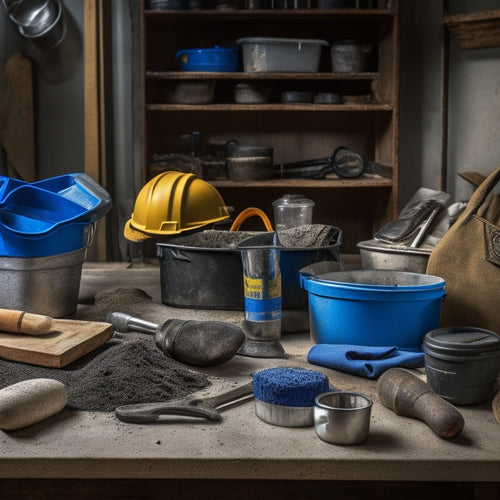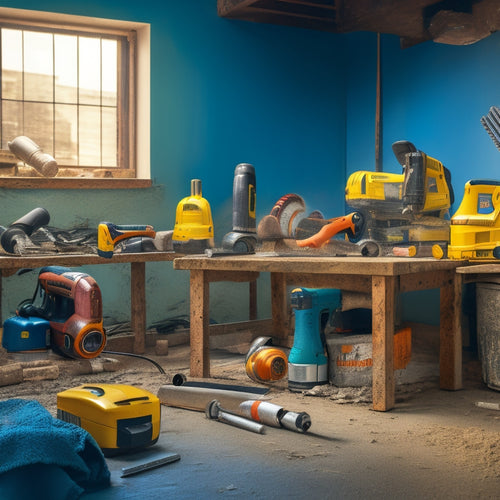
Selecting the Right Tools for Concrete Block Repair
Share
When selecting the right tools for concrete block repair, you'll want to identify the type of block, assess the extent of damage, and determine the best repair method. Choose sealants with strong adhesive strength, considering factors like moisture resistance and flexibility. Evaluate tool durability based on materials, construction quality, and maintenance requirements. Consider tool accessories that enhance efficiency and simplify application. Budget wisely, investing in quality tools and versatile accessories. By combining the right tools with a solid understanding of sealing techniques and application methods, you'll be well on your way to a successful repair - and there's more to explore to guarantee a strong, long-lasting fix.
Key Takeaways
- Identify the type of concrete block to determine the most suitable tools and repair strategies for the specific project.
- Evaluate the extent of damage to decide between complete replacement or patching of broken blocks, considering environmental factors.
- Select sealants with high adhesive strength, flexibility, and moisture resistance to ensure effective bonding with concrete blocks.
- Choose tools with durable materials, ergonomic design, and low maintenance requirements to enhance productivity and reduce costs.
- Consider multi-purpose tools and prioritize essential accessories to allocate budget efficiently and ensure project success.
Assessing Your Cinder Block Needs
As you stand before the damaged cinder block structure, take a moment to methodically assess the situation. Identify the type of block you're working with, as this will inform your repair strategy.
Different block types, such as solid, hollow, or insulated, require distinct approaches. For instance, hollow blocks may require additional support or specialized filling materials, while insulated blocks may need thermal insulation replacement.
Next, evaluate the extent of the damage and determine the necessary repair methods. Are cracks superficial or do they compromise the structural integrity of the wall?
Do broken blocks need to be replaced entirely, or can they be patched? Consider the environmental factors that led to the damage, such as weather exposure or water infiltration, to guarantee your repair addresses the root cause.
Evaluating Sealing Tool Quality
When selecting a sealing tool, you'll want to evaluate its sealant adhesive strength to guarantee a strong bond between the concrete block and the sealant.
Additionally, you should consider the tool's durability, as it will be subject to wear and tear during the repair process.
Sealant Adhesive Strength
You need to evaluate the sealant adhesive strength of a sealing tool to confirm it can effectively bond with the concrete block. This is vital in guaranteeing a strong and lasting repair.
Sealant adhesive strength varies depending on the type of sealant used. For instance, polyurethane-based sealants typically offer high adhesive strength, making them suitable for high-traffic areas or exposed joints. On the other hand, acrylic-based sealants are more flexible and suitable for areas subject to movement or vibration.
When evaluating sealant adhesive strength, consider the specific adhesive applications required for your concrete block repair project. Will the sealant be exposed to water, chemicals, or extreme temperatures? Does it need to withstand heavy loads or traffic?
By understanding the demands of your project, you can select a sealing tool with the appropriate sealant type and adhesive strength to confirm a successful repair.
Tool Durability Matters
Selecting a sealing tool that can withstand the rigors of concrete block repair is essential to the success of the project.
You'll want to evaluate the tool's durability to guarantee it can handle the demands of the job. A tool's lifespan is directly tied to its material resistance. Look for tools made from high-quality, durable materials that can resist corrosion, abrasion, and impact.
When inspecting the tool, check for signs of wear and tear, such as cracks, dents, or rust.
A well-made tool will be able to withstand the physical demands of concrete block repair, including exposure to harsh chemicals and extreme temperatures. A tool that can't withstand these conditions will have a shorter lifespan, leading to increased costs and downtime.
Considering Tool Durability Factors
Many concrete block repair projects require a considerable investment in tools, and durability is a critical factor to reflect upon when choosing the right ones.
You'll want to evaluate the tool material, as it notably impacts durability. For instance, high-carbon steel tools are more resistant to corrosion and wear than those made from lower-quality materials.
Additionally, you should think about the environmental impact of your tools. Tools with a longer lifespan reduce waste and minimize the need for frequent replacements, resulting in a lower environmental footprint.
When evaluating tool durability, you should also take into account the construction quality, ergonomic design, and maintenance requirements. A well-balanced tool with comfortable grips and intuitive handling reduces fatigue and improves productivity.
Furthermore, tools with easy maintenance features, such as removable and replaceable parts, extend their lifespan and reduce downtime.
Understanding Sealing Technique Options
Effectively sealing concrete blocks is essential to preventing water infiltration and guaranteeing the structural integrity of the repaired area.
When it comes to sealing techniques, you'll need to determine the best approach for your specific repair job. You can choose from various sealing techniques, including surface sealing, injection sealing, and crack injection.
Surface sealing involves applying a sealant directly to the surface of the concrete block, while injection sealing involves drilling holes and injecting sealant into the block. Crack injection involves injecting sealant directly into cracks and joints.
You'll also need to evaluate the application methods for your chosen sealant. Will you use a brush, roller, or sprayer to apply the sealant? Each method has its own advantages and disadvantages, and the right choice will depend on the size and complexity of your repair job.
Additionally, you'll need to take into account factors such as temperature, humidity, and surface preparation to guarantee a successful seal. By understanding the different sealing techniques and application methods, you can make informed decisions and achieve a high-quality seal that will last for years to come.
Choosing the Right Sealant Type
When selecting a sealant for concrete block repair, you'll need to take into account the properties that matter most for your specific project.
You'll want to think about the adhesive strength options, as some sealants are designed for high-bond applications, while others are better suited for low-stress environments.
Sealant Properties Matter
As you prepare to repair your concrete blocks, the sealant you choose can make all the difference in the success of the project. You need a sealant that can withstand the unique demands of concrete block repair.
When selecting a sealant, take into account its flexibility. A flexible sealant will absorb vibrations and movements, guaranteeing a strong bond between the blocks. Look for sealants with high elasticity to confirm they can stretch and compress without cracking.
Moisture resistance is another critical property to bear in mind. Concrete blocks are prone to water damage, so a sealant with high moisture resistance will help prevent water from seeping into the blocks. This is especially important in areas with high humidity or exposure to water.
Adhesive Strength Options
Select the right sealant type for your concrete block repair project by considering the adhesive strength options available.
You'll want to choose a sealant that can withstand the stresses and loads your concrete block structure will encounter. Adhesive types vary in their bonding performance, so it's crucial to understand the differences.
Epoxy-based adhesives offer high bonding strength, making them suitable for structural repairs. They provide excellent resistance to chemicals, water, and extreme temperatures.
Acrylic-based adhesives, on the other hand, offer moderate bonding strength and are ideal for non-structural repairs. They're more flexible and easier to apply than epoxy-based adhesives.
Polyurethane-based adhesives provide high bonding strength and are suitable for both structural and non-structural repairs. They're flexible and resistant to water and chemicals.
When selecting a sealant, consider the specific requirements of your project.
Will the repair be subject to heavy loads or extreme weather conditions? Do you need a sealant that can bond to damp or wet surfaces?
Selecting Appropriate Tool Accessories
You'll find that the right tool accessories can considerably impact the efficiency and quality of your concrete block repair project. To guarantee seamless integration, consider tool compatibility when selecting accessories. This involves verifying that the accessory is designed for your specific tool make and model.
Failure to do so can lead to subpar performance, damage to the tool or accessory, or even safety hazards.
Accessory types vary widely, and understanding their functions is essential. For instance, drill bits and mixing paddles are designed for specific tasks and materials.
Using the wrong accessory can compromise the integrity of your repair or lead to unnecessary wear on your tools. When choosing accessories, prioritize those that cater to your project's unique demands.
For example, if you're working with particularly dense or abrasive concrete, select accessories engineered to handle these conditions. By doing so, you'll guarantee that your tools perform at their best, and your concrete block repair project meets the highest standards.
Tool Maintenance and Repair Priorities
Frequently, concrete block repair projects are plagued by tool downtime, which can lead to costly delays and jeopardize the overall success of the project.
You can't afford to have your tools out of commission when you need them most. That's why it's essential to establish a routine for tool maintenance and repair.
Start by assigning a designated area for tool storage, ensuring they're clean, dry, and protected from the elements.
Next, create a maintenance schedule to inspect and service your tools regularly. This will help identify potential issues before they become major problems.
Prioritize repairs based on the tool's importance to the project and the severity of the damage.
Don't wait until a vital tool breaks down to address the issue.
Budgeting for Tool Purchases
Budgeting for tool purchases is a crucial aspect of concrete block repair projects, as it directly impacts the success and profitability of the endeavor.
You must carefully plan and allocate your resources to make certain you have the necessary tools without exceeding your budget constraints.
When budgeting for tool purchases, consider the following cost-effective options:
-
Prioritize essential tools: Focus on purchasing the most critical tools required for the project, and defer non-essential items until later.
-
Opt for multi-purpose tools: Invest in tools that can serve multiple purposes, reducing the need for multiple specialized tools.
-
Buy quality over quantity: While it may be tempting to buy cheaper options, investing in high-quality tools will save you money in the long run by reducing the need for frequent replacements.
Frequently Asked Questions
Can I Reuse Old Tools for a New Concrete Block Repair Project?
When deciding whether to reuse old tools, you'll need to assess their condition and compatibility with your new concrete block repair project; inspect for wear, damage, or corrosion, and make certain they're suitable for the specific task at hand.
How Do I Dispose of Old or Broken Concrete Block Repair Tools?
You're not stuck with a graveyard of rusty, broken tools! Explore tool disposal methods that don't harm the planet - responsibly recycle, repurpose, or donate still-useful items, and opt for environmentally friendly options to minimize waste and guilt.
Are Concrete Block Repair Tools Suitable for Other Masonry Work?
As you explore tool versatility, you'll find that many concrete block repair tools are compatible with other masonry work, such as bricklaying or stonework, making them a worthwhile investment for your overall masonry projects.
Can I DIY Manufacture My Own Concrete Block Repair Tools?
As you coincidentally stumble upon a DIY YouTube video, you wonder: can you really manufacture your own concrete block repair tools? While it's possible, you'll need to master tool manufacturing techniques, grasp metallurgy, and invest in specialized equipment, making DIY approaches less feasible than buying purpose-built tools.
Are There Any Safety Certifications for Concrete Block Repair Tools?
You should look for tools meeting safety standards like ANSI and OSHA regulations, ensuring your concrete block repair work adheres to industry benchmarks. Regular tool maintenance is also essential to prevent accidents and guarantee peak performance.
Conclusion
You've made it to the final step in selecting the right tools for concrete block repair. With a thorough assessment of your needs, evaluation of tool quality, and consideration of durability and technique, you're ready to tackle any project. Did you know that the concrete repair industry is projected to reach $3.3 billion by 2025? With the right tools and know-how, you'll be well-equipped to capitalize on this growing market. Now, get out there and start repairing!
Related Posts
-

5 Tools Needed for Quick Fix Concrete Mixing
You'll need five essential tools to tackle a quick fix concrete mixing project efficiently. First, you'll require a s...
-

Free Design Tools for Concrete House Planning
You can kick-start your concrete house planning project without breaking the bank, as there are several free design t...
-

Essential Power Tools for Concrete Block Construction
When building with concrete blocks, you'll need a range of power tools to cut, drill, mix, and finish the blocks to g...


